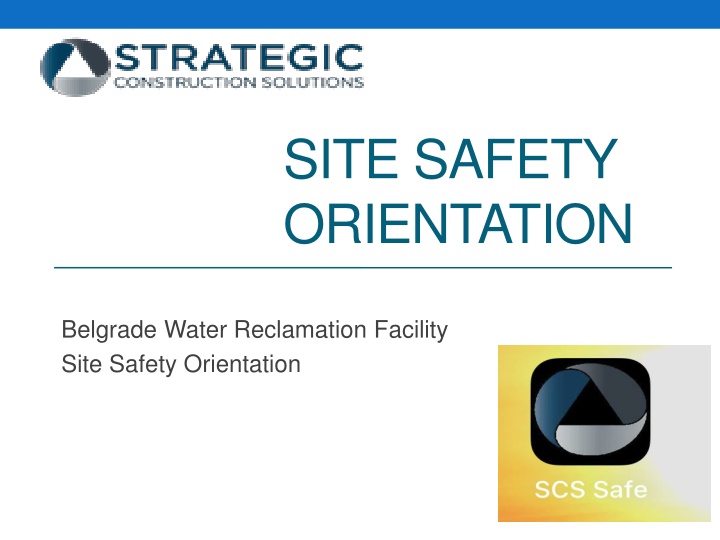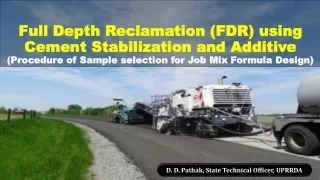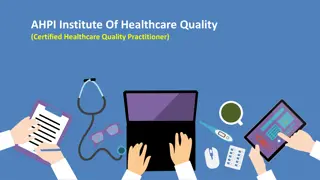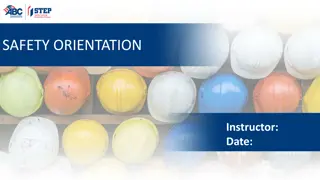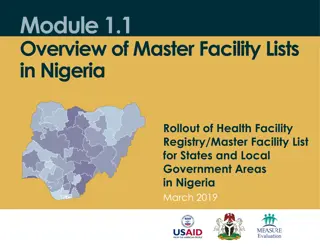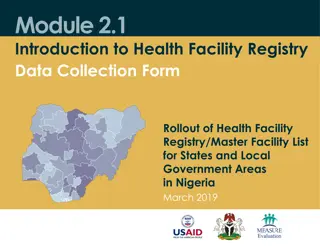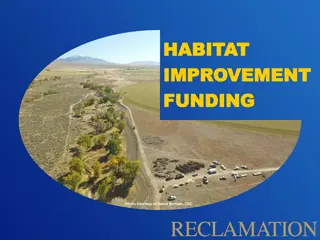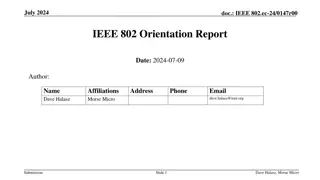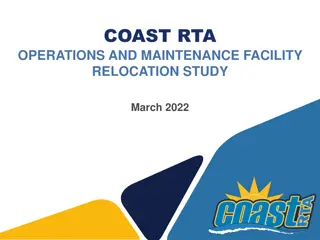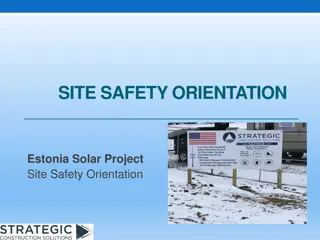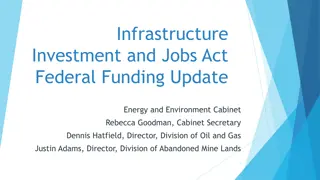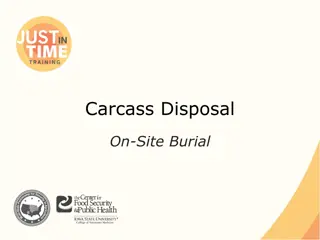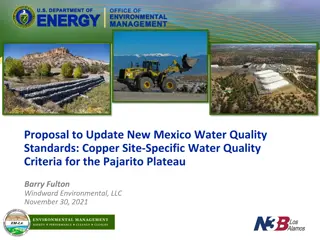Comprehensive Site Safety Orientation at Belgrade Water Reclamation Facility
This safety orientation at the Belgrade Water Reclamation Facility covers key safety philosophy, principles, and fundamentals to foster a safe work environment. It emphasizes personal accountability, zero tolerance for unsafe behaviors, and a commitment to continuous improvement. Employees are expected to actively engage in promoting a safety culture to prevent incidents and ensure a safe workplace for all.
Download Presentation

Please find below an Image/Link to download the presentation.
The content on the website is provided AS IS for your information and personal use only. It may not be sold, licensed, or shared on other websites without obtaining consent from the author.If you encounter any issues during the download, it is possible that the publisher has removed the file from their server.
You are allowed to download the files provided on this website for personal or commercial use, subject to the condition that they are used lawfully. All files are the property of their respective owners.
The content on the website is provided AS IS for your information and personal use only. It may not be sold, licensed, or shared on other websites without obtaining consent from the author.
E N D
Presentation Transcript
SITE SAFETY ORIENTATION Belgrade Water Reclamation Facility Site Safety Orientation
2 Today We Will Review key philosophy, principles, and fundamentals of SCS safety Review site background, community, history, and any safety issues in the site environment Review site rules Site Safety Coordinator: Cody Prosser 480-665-7943 cprosser@scsbuild.com
3 Safety Philosophy, Principles, and Fundamentals
4 SCS s Safety Philosophy Champion safety as our highest priority. Event free operation can only be attained if safety is reflected in every behavior personnel safety, contractor safety, and public safety Foster a safety culture in which everyone believes and demonstrates that accidents, injuries and illnesses are preventable and everyone understands their responsibility for maintaining such a workplace Ensure personal accountability by employees and contractors in ensuring their safety, the safety of those working around them, and the safety of the public Believe you can make a difference Demonstrate a desire and commitment to continuously improve We believe that employee and contractor safety are synonymous, as both hold the same responsibilities to ensuring we remain safe in all of our work environments
5 SCS s Safety Principles Employees are expected to take an active role in their personal safety All safety incidents can be avoided if appropriate use of safety processes, procedures, tools and past experiences are shared and communicated As a company, we aspire to ensure employees return from work each day as healthy as they come Our work is never so urgent, nor our schedule so important, that work cannot be performed safely Uphold a Zero Tolerance culture
6 SCS s Zero Tolerance Culture Unsafe behaviors are corrected and coached immediately Unsafe conditions are reported and corrected as soon as possible Working any other way is not acceptable
7 Safety Fundamentals Accept personal accountability for your safety and those working around you All personnel are responsible for continually assessing their safety work practices Focus on hazard identification/assessment then hazard prevention/control Report all work-related injuries, illnesses, unsafe conditions or practices and near misses to supervision and site management
8 Safety Fundamentals (Cont d) Be responsible for your own safety Don t put yourself in potentially dangerous situations Assess the hazards (Job Hazard Analysis Checklist will be covered this in more detail) Be aware of your surroundings Ensure a clean and uncluttered workspace (good housekeeping ) Identify potential for events Slips, trips, falls Struck or struck by (falling objects, sharp objects, etc.) Over exertion (lifting, pushing, pulling, reaching, twisting, climbing) Cumulative trauma/repetitive motion Control or prevent the hazard Remove/disable the potential hazard Change behavior or process to mitigate the hazard
9 Safety Fundamentals (Cont d) Know and understand SCS s safety principles, human performance principles, and human error prevention Leverage Human Performance Tools to enable you to be safer and create a safer environment for others Utilize checklists, forms, and other tools (Job Hazard Analysis, Pre-Job Briefings, Tailgate Meetings, etc.) if they apply and can help you create a safer environment Consider and use the appropriate equipment and personal protection for any work Conduct thorough investigations of incidents
10 Safety Fundamentals (Cont d) All personnel should maintain a questioning attitude and always look to answer the 4 Critical Questions What are the CRITICAL STEPS in the task? What are the ERROR LIKELY situations? What is the WORST THING that can go wrong? What DEFENSES are we relying upon?
11 Safety Fundamentals (Cont d) Human Performance Tools Self-Check (STAR) Stop, Think, Act, Review Peer Check First Check Concurrent Verification Independent Verification Workers Observing Workers (WOW) Pre-Job Brief (PJB)
12 Safety Fundamentals (Cont d) Self-Check (STAR) Stop Pause before performing your task, to enhance the attention to detail. Attempt to eliminate current or potential hazards. Think Understand specifically what is to be done before performing the task. Question the situation by trying to identify all information pertinent to the task or job. Determine if the task is appropriate for the given conditions and consider both the expected responses and results. Decide what contingency plans are required and get responses to any unanswered questions. Act Conduct the activity as intended or agreed to. Review Verify that the actual response is the expected response/result. Take the agreed-to contingency action is the actual response was unexpected.
13 Safety Fundamentals (Cont d) Workers Observing Workers (WOW) Observe yourself and your colleagues Ensure employees and contractors take a personal interest in the safety of anyone working within an SCS facility Actively provide feedback to anyone when unsafe behaviors and unsafe acts are observed (below are some suggested approaches) Leverage humor to help coach any unsafe behaviors Show you care about your colleagues safety Assume they don t realize what is unsafe about their behavior Ask permission to provide some feedback on the situation or behavior Positively reinforce those behaviors that are good Lead by example Utilize our GOOD CATCH Program
14 Safety Fundamentals (Cont d) Pre-Job Brief (PJB) Performed for all physical work activities Purpose Ensure all affected personnel understand the scope and expectations of a given work activity Create an environment of open, candid communication where the work can be discussed and evaluated for all to understand Conducted before the start of each job, and involves all workers that will be participating on the particular job Cover at least the following: Hazards associated with the job Work procedures involved Special precautions Energy source controls PPE requirements
15 Safety Fundamentals (Cont d) Pre-Job Brief (PJB) Cont d At least one PJB conducted before each day, or before a new shift begins work Additional PJB shall be held if any significant changes occur which might affect the safety of the employee Working alone does not prevent you from conducting your own, informal PJB, using the same evaluation criteria and elements Site employees are responsible for ensuring that these are being held, and that they are being done correctly and appropriately (even if the contractor is leading and owning the PJB) PJB should answer the 4 Critical Questions (reminder below) What are the critical steps in this task? What are the error likely situations? What is the worst thing that can go wrong? What defenses are we relying upon?
16 Safety Fundamentals (Cont d) Pre-Job Brief An Example of What Good Looks Like PJB leader has adequately prepared for the PJB knows the content, the hazards, and the work PJB is done in an appropriate location that allows personnel to pay attention and hear the review All required attendees are present and attentive Brief properly covers Job purpose, expected results, and scope Roles and responsibilities of personnel involved Human performance tools discussed and reviewed Actions and safe practices to prevent any errors and review of error-likely situations Review and discussion of potential hazards Review of communication requirements Review of any safety or environmental requirements Discussion of conditions that would result in work stoppage or supervisor notification Review of any lessons learned from recent or similar jobs Review, and answer of the 4 Critical Questions PJB leader does not employ a sense of urgency that promotes the atmosphere of time pressure to complete the task PJB leader solicits participation
17 360 WALK AROUNDS Place your cone on the hood of your vehicle when you park. Prior to leaving, walk counterclockwise around the vehicle/trailer to ensure the vehicle is ready for operation and collect the cone as you pass the hood of the vehicle to return to the driver s seat
18 Site Background, Community, History, and Environment
19 Site Background and History The city of Belgrade received a $3 million contribution from the Bozeman Yellowstone International Airport on a new $40 million wastewater facility to allow for more growth in the near future. City engineers estimated the airport s water and sewer use to be 7.5% of the city s total usage. The Gallatin Airport Authority Board, the governing body of the airport, agreed to pay 7.5% of the total cost of the $40 million upgrade According to Belgrade City Manager Ted Barkley the facility will be built almost completely underground to prevent any eyesores. The current wastewater and sewage facility is at its max capacity of connections, just over 4,000, and will double their capacity with the new upgrade. If the facility is not built, the room for growth of residential and commercial areas will be halted.
20 Site Background and History (CONT D)
21 Community Relations Maintain a Good Neighbors perspective Observe speed limits (beyond limits already in place at the site) Maintain respect for the land and natural preserves in the area Act in a professional manner, representing your company, and SCS, in a positive light with the local community Avoid backing up in non participants driveways Protesters / Media Do not engage Call an SCS representative or your supervisor
22 Environment and Safety Insects and spiders in the area Deer Tick CDC is predicting a record high this year Black Widow Spiders Deer Tick
23 Environment and Safety (Cont d) Best method of removal Attempt to remove tick or critter with tweezers Do not leave the head Apply antibiotic Seek medical treatment if rash or swelling occurs Keep the tick for the medical examiner Spider nesting can often be found in or under: Conex boxes Pallets Office boxes Wooden pallets Delivered or stages supplies and equipment Wooden spools Port-a-potties/Check under the seat Typically warm areas
24 Montana Spiders The only spider commonly found in Montana with venom harmful to humans is the black widow. Its venom causes latrodectism, which results in persistent sweating, muscle cramping, and other neurological responses. Bites from black widows are very rare. The hobo spider, which has also been called the aggressive house spider, is present in most of central and western Montana. It does not cause necrotic lesions and is not directly harmful, despite misinformation on the internet. There has been significant research on this subject over the last decade and any suggestions that hobo spider bites or lesions are dangerous has been discredited. Nevertheless, if a wound becomes inflamed or soreness persists, medical care should be sought as secondary infection can enter the body through the wound.
25 Montana Spiders (CONT D) To minimize the risk of spider bites, take caution when working in crawl spaces, garages, the laundry room, and in areas that are not often encountered. In general, bites are rare from spiders because they are small, their fangs are small, and they lack the musculature to pierce the human skin. If think you have a spider bite, see a dermatologist if your symptoms persist. Facts about the brown recluse and other spiders in Montana: The brown recluse has never been positively identified in Montana The brown recluse bite causes localized necrotic lesions on the skin due to a toxin in its venom Necrotic lesions can be caused by several factors, including some spider bites or secondary infections in the bite area The most common cause for such necrotic lesions in areas of the country where brown recluse spiders are not found (such as Montana) is MRSA (Methicillin Resistant Staphlococcus aureus infection) A brown recluse spider must be identified by an experienced professional The black widow is the only spider harmful to humans that has been identified in Montana Hobo spiders are present in Montana but are not aggressive and do not cause necrotic lesions If you find a spider or insect of concern, please place it in a leak-proof container and either freeze it or preserve it in rubbing alcohol. Bring the sample to your local county Extension office or mail it to the Schutter Diagnostic Lab at 119 Plant BioScience Bldg, PO Box 173150, Bozeman, MT, 59717-3150.
26 Environment and Safety (Cont d) Snakes Rattlesnake Montana's only venomous snake is the Prairie Rattlesnake Found near wetlands during spring Move upland to Sun themselves Hints for avoidance Keep watch in high vegetation Avoid them if seen Rattlesnakes will avoid contact Do not harass or approach Deer/Elk/Moose Watch for deer coming out of ditches Crossing wooded areas Leaving fields
27 Extreme Weather Always be aware of the weather conditions, and the weather forecast, at your site and in your work area Site management makes weather-related Stand Down determinations, BUT All personnel have an obligation to stop work if extreme weather is observed and they have not yet been notified by site management Lightning Work will not be done in or around elevated structures within 30 miles A lightning strike within 30 miles of any elevated work will constitute a Stand Down . Civil will Stand Down when lightning is within 15 miles of site. Workers observing lightning or who are notified by their supervisor of a lightning strike will assemble according to the site emergency evacuation plan Stand Downs will last 30 minutes past the last lightning strike within 30 miles of the elevated work, 15 miles for civil or longer if deemed necessary by site management
28 Extreme Weather (Cont d) High Wind Weather monitoring should be conducted during all work in progress Work in progress should be halted prior to wing speeds reaching the limits mentioned below if the wind speeds are increasing and/or are forecasted to achieve or exceed the limits mentioned Limitations mentioned are guidelines more specific wind speed limitations can be obtained by site management for the given equipment manufacturer
29 Extreme Weather (Cont d) Tornado Extremely likely in this area of the country Seek a storm shelters if one is accessible Seek refuge in low lying areas such as a ditch Do not shelter in vehicles, equipment or trailers. Ground Fire Range, grass, crop and forest fires can be fast moving and endanger personnel working in grassy/mid range vegetation areas. Air quality should be taken into consideration when fires are present Any ground fires shall be reported to site management immediately **DO NOT** TRY TO BE A FIRE FIGHTER. GET TO SAFETY AND CALL 911 IF NEEDED!!
30 Site Safety Rules
31 Basic Site Safety Rules Personnel on site must be 18 years or older No pets and/or children No firearms/weapons/knives allowed on site Illicit drugs and paraphernalia are prohibited Alcohol is not allowed Smoking/tobacco use only in designated areas Ensure you are fit for duty Obey all signs/posters and barricades Jewelry and/or loose clothing not permitted No horseplay/running/fighting No reckless driving in snowy, icy, or muddy conditions All personnel have a right to refuse unsafe work All personnel have a stop work obligation
32 Basic Site Safety Rules (Cont d) Maintain good housekeeping Speed limit on site access roads is 15 mph Speed limit in lay down yard area is 5 mph Training records and attendance are maintained on site and available to SCS upon request Personnel shall only perform tasks upon which they have been trained to perform safely Additional training see your supervisor or safety representative. All visitors report to the SCS site office Visitors receive Orientation Site Specific Briefing Must be accompanied by a representative from the company they are visiting who has completed orientation All incidents are reported & investigated Site maintains a post-accident Drug and Alcohol screening process
33 Basic Safety Rules Substance Abuse SCS reserves the right to request a drug screen for subcontractor's in following times: Pre-Access within 30 days of starting work on an SCS Project Annual for project lasting more than 12 months Post Incident after any incident that causes serious personal injury to self or others, property damage in excess of $1,000, or motor vehicle accident as defined by the FMCSA. Reasonable Suspicion as observed by contractor or SCS management Unannounced any or all site employees at the sole discretion of SCS Random as required by DOT, other laws or the contractor policy
34 Basic Safety Rules Substance Abuse (Cont d) Prescription drugs and over the counter (OTC) medications are permissible if the following conditions have been met: Prescription drugs have been prescribed by a licensed physician for the person in possession of the drugs The prescription is not expired and was filled by a licensed pharmacist for the person possessing the drugs The individual notifies their supervisor that they will be in possession of or using, impairment-causing prescription drugs or OTC substances and appropriate steps are taken to accommodate the possible impairment SCS may also require the Contractor to conduct a search or inspection of any person on-site to include any vehicles or containers for alcohol, drugs or paraphernalia
35 Basic Safety Rules Housekeeping Contractors required to provide: Containers (dumpsters) Collection, separation, and elimination of construction waste Please use your own waste containers and not other company s Work areas policed daily and as work progresses Scrap/reusable lumber stored neatly Nails/screws removed Containers for garbage or oily waste must have covers
36 Basic Safety Rules Housekeeping (Cont d) Spills Each contractor must have a spill kit (where is yours?) Spills stopped / contained immediately and reported to SCS Safety Dept. according to SPCC plan In accordance with state and county 110% of spoil taken out and properly disposed with cradle to grave receipt.
37 Basic Safety Rules Housekeeping (Cont d) Wildlife Management The Contractor, always, shall keep all trash and construction debris confined in the staging area. Construction debris and trash shall be kept in a neat and orderly condition and secured to prevent dislodging in the wind and other weather conditions. Any trash that may be a wildlife attractant shall be disposed of in trash bins or other approved method. All fences and gates shall be maintained to prevent intrusion by wildlife. Staging areas shall be prepared to drain properly to prevent ponding of water and attracting birds and other waterfowl.
38 Basic Safety Rules Housekeeping (Cont d) Foreign Object and Debris Management (FOD) The Contractor shall keep all pavement surfaces free of debris, using vacuum sweepers or blower type equipment. All construction debris will be totally removed from the work area, unless otherwise coordinated with the Airport and Engineer. All construction stockpiled materials that must be left on-site shall be secured so that they cannot be dislodged by wind or jet blast. Stockpiled materials will be located in Contractor staging areas or as coordinated with the Engineer. Stockpiled materials will not be placed in runway and taxiway object free areas. The Contractor will not depart the project without approval of the clean up by the Airport s designated representative. Dumpsters and trash receptacles will be covered. Stockpiled material will be fastened or secured to prevent blowing onto airport.
39 Basic Safety Rules Safe Driving No personal vehicles are allowed in work areas; only company vehicles and rentals Must be labeled with company name or logo Drivers must be: Licensed Medically fit Well rested Observant and adjust driving to prevailing road conditions Not under the influence Passengers Number of passengers does not exceed manufacturer s specifications for the vehicle Functional seat belt for each passenger No persons permitted to ride in bed of pick-ups, trailers, etc.
40 Basic Safety Rules Safe Driving (Cont d) Cargo/Loads Vehicles not loaded in excess of manufacturer s specifications All loads secured to prevent displacement Loads do not extend beyond vehicle boundaries unless: Flagged, lighted, pilot vehicle, ground guide, etc, Seat Belts Worn by driver/operator and all passengers Driver s responsibility Mobile Phones/Radios No two-way communication while driving, operating equipment, etc Exception for radio use for crane/equip operators Pull off road to take call or leave work area Bluetooth devices are permissible in vehicles not equipment or while working
41 Basic Safety Rules Safe Driving (Cont d) Vehicle Maintenance Ensure that vehicles and equipment are of good, sound working condition All passenger vehicles driven to and on the jobsite must be street legal and current on registration, inspection and insurance Motorcycles Only to be used for commuting to and from the lay down yard / office parking lot and not ridden into work zones or tower areas.
42 Basic Safety Rules Stop Work Obligation Every worker is authorized and, has the obligation to STOP WORK for unsafe acts and/or conditions Every worker has the right to refuse an unsafe Work Order Does not matter who, what, where, or when You see it you own it; safety is all of our responsibilities Uphold a Zero Tolerance culture
43 Safety/Planning Meetings Several safety meetings to be held on site and enable a safe environment Tailgate or Toolbox meetings Supervisors and personnel. Meet weekly to discuss work and safety concerns. JHA Review Supervisors and personnel. Conduct prior to beginning the day s work, or beginning a new task; discuss the specific task and safety work. All Hands Safety Meeting Wednesday at 7:00am/All site personnel. Meet weekly to receive safety message from Project Manager. Plan of Day (POD) Contractor and SCS site management. Meet daily to discuss work to be performed at 4:00 pm.
44 Job Hazard Analysis (JHA) Ensure that any JHA involves personnel that have valuable input. These can include: Supervisors Workers who have performed the task previously Subject matter experts (e.g. training specialists) Break down the job into its basic steps or tasks Describe the sequence of steps to ensure clarity among all workers for the particular job Balance detail appropriately - each step should accomplish a major task Identify hazards, ensuring the use of past experience to help inform hazard identification
45 Job Hazard Analysis (JHA) Cont d Potential sources of hazards include: Line of Fire Material Handling, Walking and Working Surfaces Industrial Hygiene Ergonomics Energy Isolation Hazardous Materials Fire Weather For each hazard, list the measures to be taken to protect the worker from the particular hazard. These could include: Engineering controls (e.g. barriers and guards) Administrative controls (e.g. written procedures) Use of PPE
46 Job Hazard Analysis (JHA) Cont d The JHA can be accessed with your smart phone or tablet. On your smart phone go to www.scssafe.com , then project tab. Scroll down to your current job site and select the site. Click the blue tab in the Job Hazard Assessment (JHA) section and fill out the form and click submit at the bottom.
47 Line of Fire Line of Fire when a person places their body or body part in a position where they can be struck, sprayed, cut, burned, pinched or punctured. To avoid Line of Fire incidents: Visualize the tasks you and others are about to perform Place body parts in positions that cannot be cut, struck sprayed, etc. Do Not stand or walk under a suspended load or overhead workers Cut away from your body (Use cut resistant gloves) Always use doorknobs or handles, do not hold on side of doors/drawers Anticipate what could be struck and if you or others are in the Line of Fire Ask What is the worst thing that can happen?
48 Personal Protective Equipment (PPE) Minimum PPE while on the job site is as follows: Approved safety glasses with side shields Use zero-tint (clear) safety glasses when working in an indoor work environment unless tints are required for the task Hard hats No inappropriate/vulgar stickers Hard hats must be worn with bill facing forward Safety Toed foot wear High visibility vest, shirt or jacket (must have reflective stripes on them) Gloves, face shield, etc. dependent upon job hazard analysis (JHA), and your company policy above and beyond JHA Cut proof gloves must be used for any job using a knife or potential for hand cuts.
49 Personal Protective Equipment (PPE) Cont d Minimum PPE (cont d) General construction attire consisting of natural fiber garments (sleeve length minimum 4 , long pants, or coveralls) For climbing at heights: Safety harness including: Personal full-body fall arrest system Rated safety lanyard with 100% tie off capabilities Side D Rings/Hip Pads Front D Ring Suspension trauma straps / stirrups Gloves approved for work being performed Hard hat or Petzl style helmet Additional PPE may be required by supervisor or as work conditions require (e.g. hearing protection in all designated areas and/or where noise levels are greater than 85dB)
50 Equipment This equipment doesn t have a brain, so please use yours!
